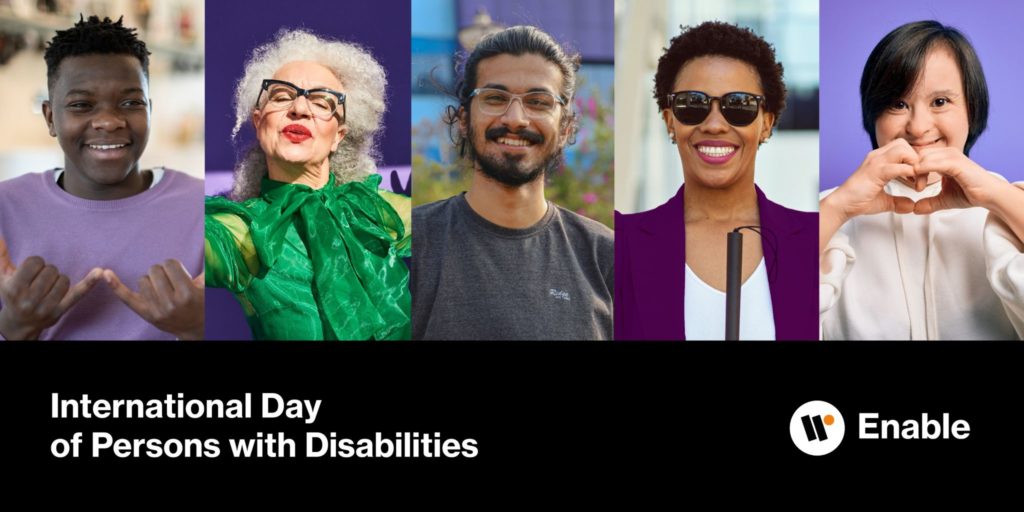How to make people with disabilities feel included in the workplace
The International Day of Persons with Disabilities on December 3 is an opportunity to raise the visibility of people with disabilities, to try and end the stigma of disability and ensure people with disabilities feel included in the workplace.
At Wavemaker we want to ensure that all our colleagues feel included and empowered to be their authentic selves at work. Therefore, it was great to see support from across Wavemaker’s global network; from people participating in the ‘Purple Challenge’ by wearing purple and lighting up Wavemaker offices, to spending an hour building knowledge with online training into how to empower people with disabilities and how to ensure we use our tech in an inclusive way.

The last two years have seen a seismic shift in our social and work lives. Covid-19 restrictions have forced us to be ‘locked down’ at home, giving us a taste of disempowerment and isolation often experienced by people with disabilities who are forced to stay at home not because of their disability, but because of physical barriers imposed by others. As we learn to live with Covid-19, hybrid working offers opportunities for people with disabilities to thrive in the workplace. Increased engagement with Diversity, Equity and Inclusion, as well as technological advances that support inclusivity mean that barriers to inclusion are starting to come down.
However, there is always more that can be done. These five tips can help organisations become more inclusive to people with disabilities.
01. Consider disability from a social rather than medical model
In the social model, disability is caused by the way society is organised, rather than by a person’s impairment or difference. It looks at ways of removing barriers that restrict life choices for disabled people. When barriers are removed, disabled people can be independent and equal in society, with choice and control over their own lives. In comparison, in the medical model, people are disabled by their impairments or differences. It looks at what is ‘wrong’ with the person and not what the person needs. It creates low expectations and leads to people losing independence, choice and control in their own lives. By focusing on the social model, you can help to remove the barriers that are holding back people with disabilities.
02. Foster a culture of psychological safety
Create safe spaces for people with disabilities to share their feelings and experiences. Many people are afraid of disclosing disability or health conditions, for fear of being seen as inadequate or incapable (which is rooted within the Medical Model and the perceptions of disabled people). Psychological safety enables people to ask for adjustments, without judgement.
03. Provide opportunities for training and education for all employees
Only through listening and education can we begin to see the world through other people’s eyes, and start to feel comfortable discussing disability sensitively and breaking down barriers to inclusion. On International Day of Persons with Disabilities every employee at Wavemaker was given an hour to complete two training programmes, both developed by people with disabilities. One module was to understand how to empower people with disabilities, the other was how to use technology inclusively.
04. Invite employees to form an ‘Employee Resource Group’
At Wavemaker we have a group called ‘Enable’: they strive to drive equity and inclusion to make our workplace more accessible for everyone, regardless of their physical or neurodiversity needs, so that we can all reach our full potential. They work to create a safe, tolerant, and inviting workspace so that everyone can be their authentic self at Wavemaker. These employee resource groups (ERGs) allow for peer to peer support and provide access to further external networks such as Purple Space.

Andreea Rashid and Jarred Trembath, our Enable ERG Leads
05. Revise and revisit
Diversity, Equity and Inclusion is a journey. We need to listen without judgement or prejudice about what is and isn’t working. Sometimes this can be difficult to hear, but it’s important to do so. Disability inclusion is an evolution of learning, change and development.
Why is diversity and inclusion important to Wavemaker?
Wavemaker embraces all kinds of difference – different voices, the other angle, the counterpoint. Together, we are positively provocative. That’s how we grow. We focus on the ability, not the disability, and would rather break down barriers than leave anyone behind.

Global Head of Diversity, Equity and Inclusion











